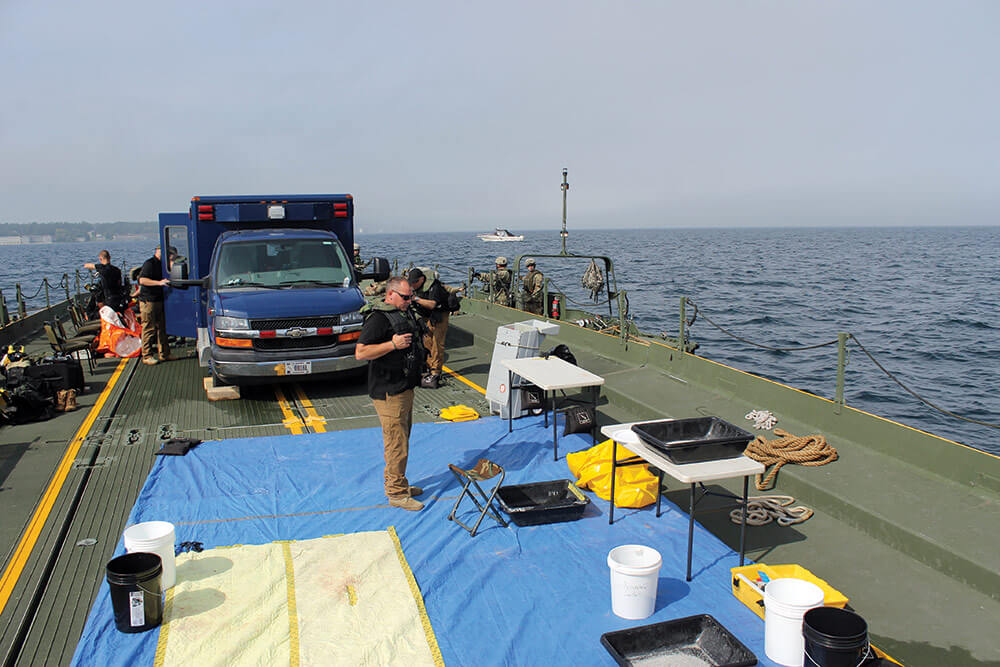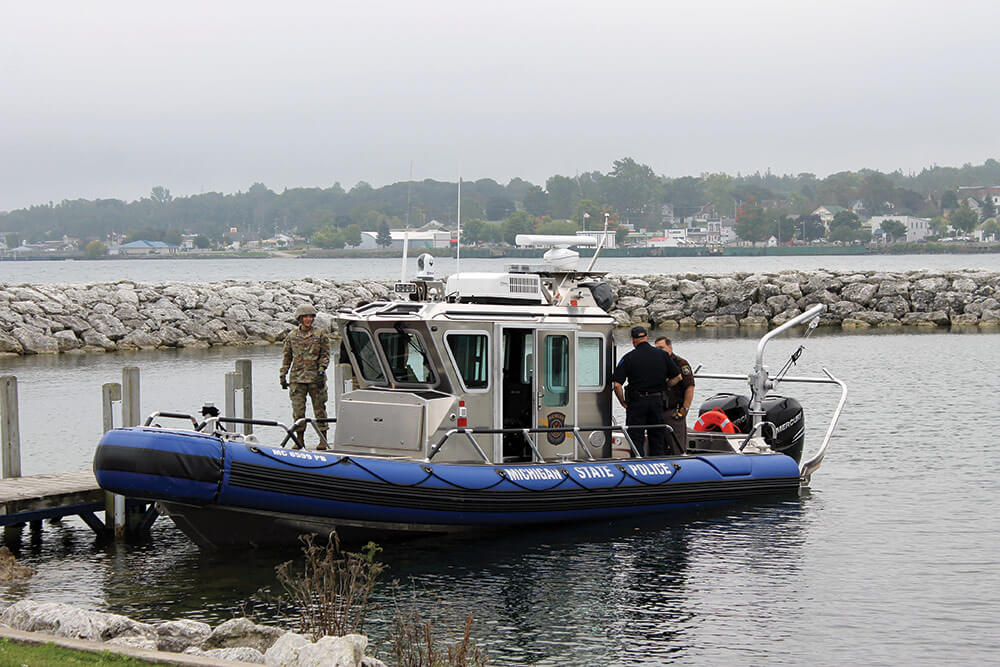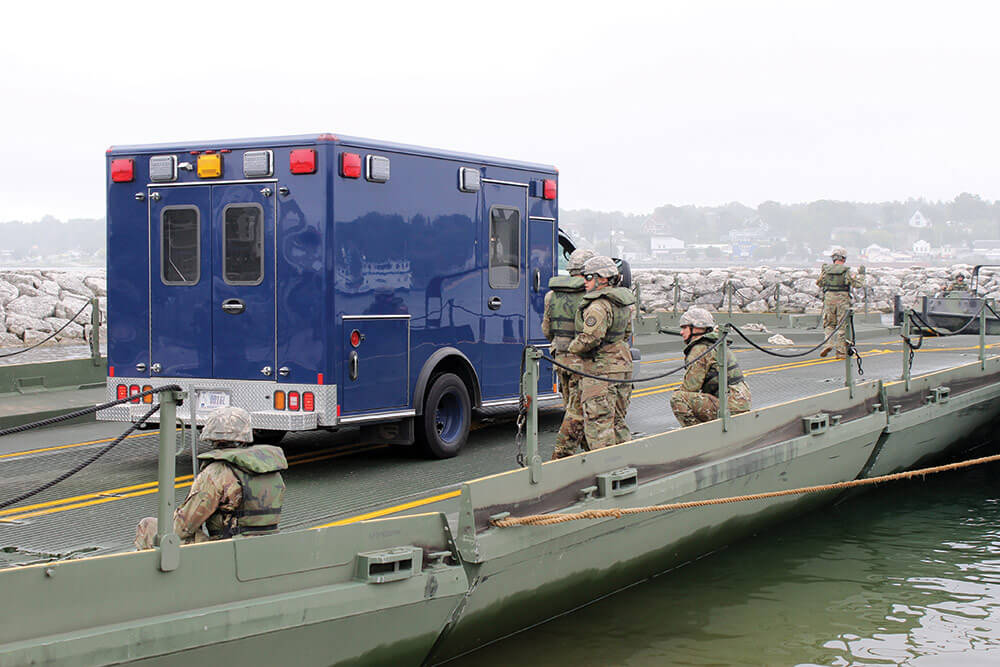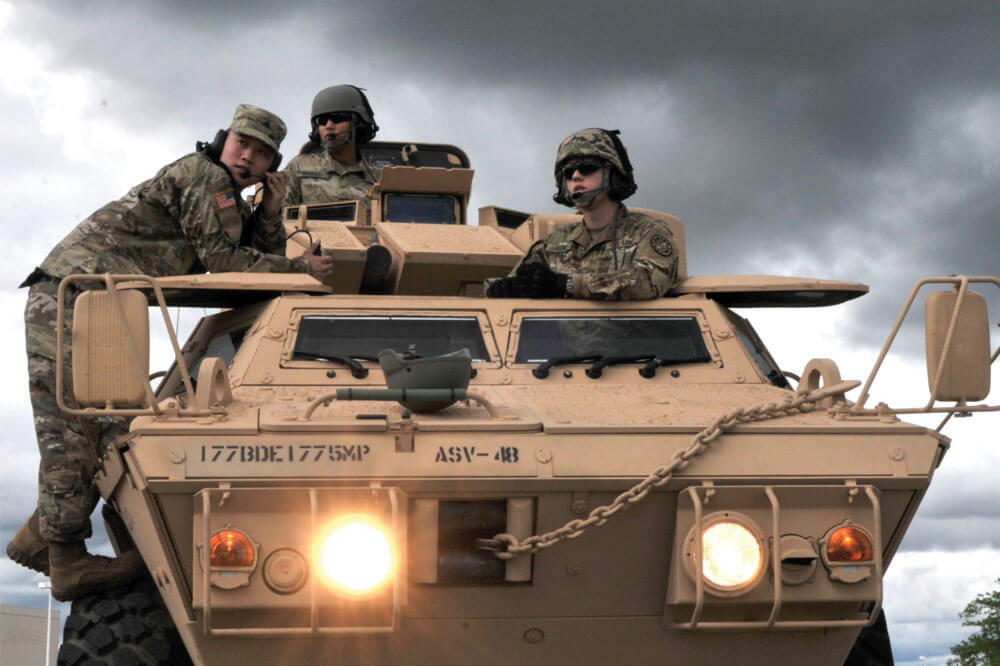Michigan Army National Guard Conducts Emergency Management Exercise
Life safety, incident stabilization and property conservation. According to Scott Martzke, the Michigan National Guard emergency management program coordinator, these are the core rules of on-the-water emergency management. They were rules that Michigan Army National Guard’s 51st Civil Support Team, along with partner organizations, would put into action during the 2017 Operation Shining Star (OSS) emergency operations training exercise.
OSS was coordinated by the 51st Civil Support Team and held in the Straits of Mackinac – a series of narrow waterways and a major shipping lane – located between Michigan’s Upper and Lower Peninsulas that connect Lake Michigan and Lake Huron. Each year, there are roughly 4.5 million crossings of the Straits of Mackinac, either by ferry or over the Mackinac Bridge.
OSS simulated a fictional scenario of a suspected radiological contamination on a ferry traveling across the Straits.
“If you have an emergency on a boat, the worst thing you can do is bring that into a populated area,” said Martzke. “If you can keep that [emergency] out on the water, you are minimizing the impact on local communities.”
To ensure the training encompassed all elements that would likely be involved in an emergency of this type, the 51st partnered with Michigan Army National Guard’s 1437th Multi-Role Bridge Company, Ohio National Guard’s 52nd Civil Support Team, the U.S. Coast Guard and the Department of Energy. Including the necessary State and local government agencies in the training, the 51st also partnered with the Mackinac County Sheriff’s Department, the Mackinac County Emergency Management Department, the Mackinac Marine Response Team, the Michigan State Police Marine Services Team (formerly the Underwater Recovery Unit), the Chippewa Central Dispatch and several other State emergency management officers. Shepler’s Mackinac Island Ferry, a civilian-operated ferry service, provided the ferry boat upon which the mock emergency occurred.

“We had a lot of great partners,” said CPT Andrea Kennedy of the 51st Civil Support Team. “[The exercise] was a great representation of who would actually be on that type of team and incident.”
Martzke agreed. “Multiple organizations worked together to achieve a common goal,” Martzke said. “We had several agencies and it was a very short planning period for this to happen. I was overly impressed by the interoperability and the cooperation with all of the agencies.”
CPT Kennedy went on to describe the function of the 51st during the operation. “As the 51st Civil Support Team, our focus is HAZMAT, weapons of destruction and anything in that range,” CPT Kennedy explained. “Our specific role was to conduct an entry onto the contaminated vessel to determine what the source of the contamination was and to determine what type of options existed for mitigating that contamination.”
The 52nd Civil Support Team worked directly with the 51st during the exercise. As the two units are based in neighboring states, they would likely be activated for a live response mission together.
The 1437th Multi-Role Bridge Company joined with the construction of a ribbon bridge that they launched from St. Ignace, Mich., and established in the waters of the Straits. The 130-foot floating ribbon bridge, also known as the Improved Ribbon Bridge (IRB), provided a platform large enough to accommodate the Civil Support Team’s ambulance, set up a decontamination corridor, support a survey entry team and their equipment, and hold the weight of a mobile operations section.
“The 1437th sets up the floating bridge wherever we can,” said SFC Ann Dailey of the 1437th. “[The IRB] and our other bridges have been erected all over the world, and our crews are the best in the Nation. We draw curious crowds wherever we go and people are impressed when they see and learn about the many ways [the bridges] can be used.”
The U.S. Coast Guard, Michigan State Police Marine Services Team and Mackinac Marine Response Team provided security and support on the water. The Coast Guard also provided safety training to Soldiers before the start of OSS. As a result, participating Soldiers became certified in small vessel boarding.

“Before the exercise, we were able to work very closely with the Coast Guard who trained us on safe vessel boarding procedures as well as safety swimming,” said CPT Matthew Guerin of the 51st Civil Support Team. “Everybody working together as a cohesive team was amazing. I don’t think there was anybody who didn’t give it a ten out of ten as far as how they thought the exercise was organized and conducted.”
The Mackinac County Emergency Management department managed the land portion of the exercise at the public boat launch in St. Ignace, Mich., which is on the southern tip of the Upper Peninsula.
“OSS is definitely a preparedness win for everyone involved,” said CPT Kennedy. “Civil Support Team Soldiers appreciate these training opportunities. Not only do these exercises give them additional experience using their equipment [as opposed to simulation settings], but they also give our team interaction time with other teams who would likely be called upon during emergencies. The familiarity and friendships formed during these exercises translate into a faster, more effective response when it really counts. Then add all the cross-training benefits from working with members of the Ohio Civil Support Team [and the Coast Guard], and readiness improves even more.”
Highlighting the dos and don’ts of effectively handling an on-the-water emergency of this type, the exercise required participants to push the limits of their prior training in order to determine the source and extent of the contamination.
“Everyone had to solve a problem that they had not thought about before,” said CPT Guerin. “This exercise was unique because it was not us going through similar motions that we always do. Everyone had to think critically about how they were going to meet the objectives.”

The exercise fostered the successful coordination of Soldiers and community resources. It showcased the importance of preparing in advance of an emergency and knowing who needs to be involved when and where.
“The thousands of people that come to Mackinac Island every year depend upon us being ready in case of an emergency, and the only way that we are ready is if we work together,” said Mackinac County Sheriff Scott Strait.
Those same citizens that Strait noted as relying on emergency responders to stay prepared, played their own role in OSS. According to Martzke, the show of support from residents and members of the local community served as a source of encouragement to the Soldiers.
“The community was extremely supportive,” said Martzke. “You never know what it’s going to look like when you take over a dozen Army vehicles into a small community like St. Ignace. But the reception and comments from the public were astonishingly positive. It was very encouraging.”
“[OSS] showed us that the community is willing to support and help in times of need,” said CPT Kennedy. “It brought to light that when an emergency happens, people will come to the table, the coordination will happen and the team will problem-solve.”
In addition to providing valuable training, OSS illuminated the many challenges involved in managing a collaborative response with multiple organizations. CPT Kennedy praised the participants and leaders for their efforts in creating a successful exercise.
“The exercise showed that there are a lot of challenges when it comes to utilizing resources in the area. When you have that many agencies with different assets and different capabilities, how do you fit all of those pieces together? It’s a [good] problem to have. We have a lot of great partners,” CPT Kennedy noted. “It’s a really good example of the partnerships that come out of the National Guard and that come out of units; organizations and people who really care about their communities.”
With the success of OSS 2017 still fresh in the minds of participants and leaders, CPT Kennedy reflected on the overall benefits of the event.
“The benefits here were huge,” CPT Kennedy said. “It gave us the opportunity to train in a unique environment that provided us with new and different operational variables and challenges. It was the first time we worked with the 1437th and it’s always an amazing opportunity when you can work with sister units and organizations that have a different capability.”
Looking to the future, Martzke noted that plans are afoot for more emergency management exercises like OSS. The Michigan Army National Guard is already coordinating several exercises slated for 2018 and beyond in the Upper Peninsula and waters of the Great Lakes.
By Staff Writer Tatyana White-Jenkins



